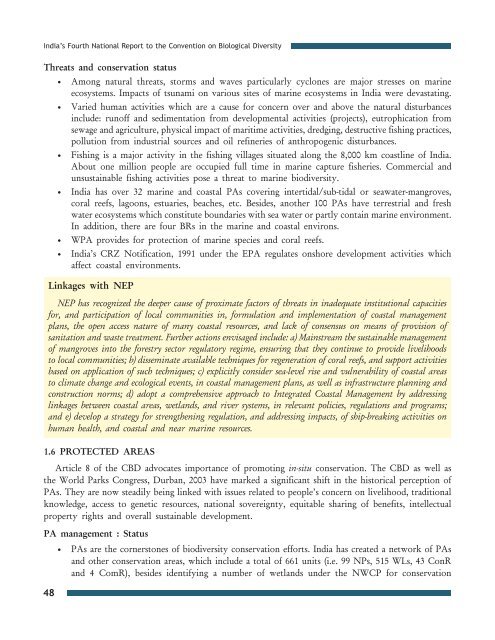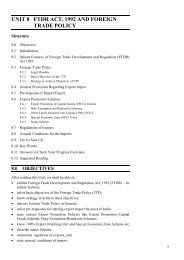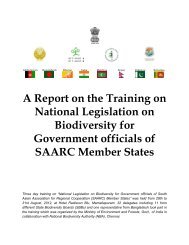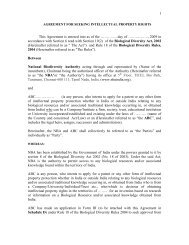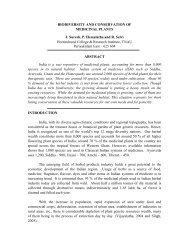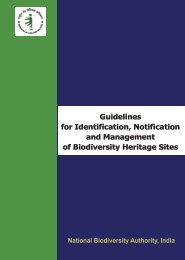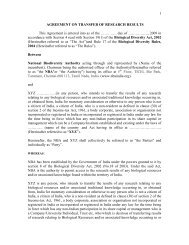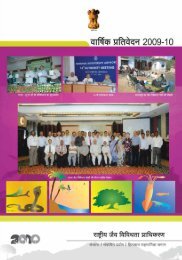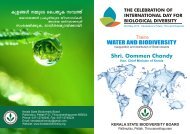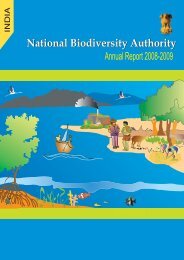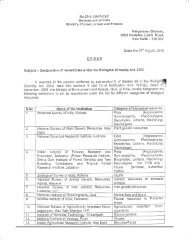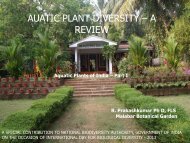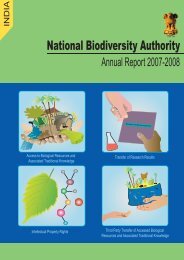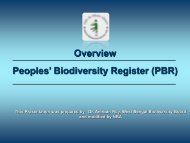Part 1 - English version (PDF) - Convention on Biological Diversity
Part 1 - English version (PDF) - Convention on Biological Diversity
Part 1 - English version (PDF) - Convention on Biological Diversity
You also want an ePaper? Increase the reach of your titles
YUMPU automatically turns print PDFs into web optimized ePapers that Google loves.
India’s Fourth Nati<strong>on</strong>al Report to the <str<strong>on</strong>g>C<strong>on</strong>venti<strong>on</strong></str<strong>on</strong>g> <strong>on</strong> <strong>Biological</strong> <strong>Diversity</strong><br />
Threats and c<strong>on</strong>servati<strong>on</strong> status<br />
<br />
<br />
<br />
<br />
<br />
<br />
Am<strong>on</strong>g natural threats, storms and waves particularly cycl<strong>on</strong>es are major stresses <strong>on</strong> marine<br />
ecosystems. Impacts of tsunami <strong>on</strong> various sites of marine ecosystems in India were devastating.<br />
Varied human activities which are a cause for c<strong>on</strong>cern over and above the natural disturbances<br />
include: runoff and sedimentati<strong>on</strong> from developmental activities (projects), eutrophicati<strong>on</strong> from<br />
sewage and agriculture, physical impact of maritime activities, dredging, destructive fishing practices,<br />
polluti<strong>on</strong> from industrial sources and oil refineries of anthropogenic disturbances.<br />
Fishing is a major activity in the fishing villages situated al<strong>on</strong>g the 8,000 km coastline of India.<br />
About <strong>on</strong>e milli<strong>on</strong> people are occupied full time in marine capture fisheries. Commercial and<br />
unsustainable fishing activities pose a threat to marine biodiversity.<br />
India has over 32 marine and coastal PAs covering intertidal/sub-tidal or seawater-mangroves,<br />
coral reefs, lago<strong>on</strong>s, estuaries, beaches, etc. Besides, another 100 PAs have terrestrial and fresh<br />
water ecosystems which c<strong>on</strong>stitute boundaries with sea water or partly c<strong>on</strong>tain marine envir<strong>on</strong>ment.<br />
In additi<strong>on</strong>, there are four BRs in the marine and coastal envir<strong>on</strong>s.<br />
WPA provides for protecti<strong>on</strong> of marine species and coral reefs.<br />
India’s CRZ Notificati<strong>on</strong>, 1991 under the EPA regulates <strong>on</strong>shore development activities which<br />
affect coastal envir<strong>on</strong>ments.<br />
Linkages with NEP<br />
NEP has recognized the deeper cause of proximate factors of threats in inadequate instituti<strong>on</strong>al capacities<br />
for, and participati<strong>on</strong> of local communities in, formulati<strong>on</strong> and implementati<strong>on</strong> of coastal management<br />
plans, the open access nature of many coastal resources, and lack of c<strong>on</strong>sensus <strong>on</strong> means of provisi<strong>on</strong> of<br />
sanitati<strong>on</strong> and waste treatment. Further acti<strong>on</strong>s envisaged include: a) Mainstream the sustainable management<br />
of mangroves into the forestry sector regulatory regime, ensuring that they c<strong>on</strong>tinue to provide livelihoods<br />
to local communities; b) disseminate available techniques for regenerati<strong>on</strong> of coral reefs, and support activities<br />
based <strong>on</strong> applicati<strong>on</strong> of such techniques; c) explicitly c<strong>on</strong>sider sea-level rise and vulnerability of coastal areas<br />
to climate change and ecological events, in coastal management plans, as well as infrastructure planning and<br />
c<strong>on</strong>structi<strong>on</strong> norms; d) adopt a comprehensive approach to Integrated Coastal Management by addressing<br />
linkages between coastal areas, wetlands, and river systems, in relevant policies, regulati<strong>on</strong>s and programs;<br />
and e) develop a strategy for strengthening regulati<strong>on</strong>, and addressing impacts, of ship-breaking activities <strong>on</strong><br />
human health, and coastal and near marine resources.<br />
1.6 PROTECTED AREAS<br />
Article 8 of the CBD advocates importance of promoting in-situ c<strong>on</strong>servati<strong>on</strong>. The CBD as well as<br />
the World Parks C<strong>on</strong>gress, Durban, 2003 have marked a significant shift in the historical percepti<strong>on</strong> of<br />
PAs. They are now steadily being linked with issues related to people’s c<strong>on</strong>cern <strong>on</strong> livelihood, traditi<strong>on</strong>al<br />
knowledge, access to genetic resources, nati<strong>on</strong>al sovereignty, equitable sharing of benefits, intellectual<br />
property rights and overall sustainable development.<br />
PA management : Status<br />
<br />
PAs are the cornerst<strong>on</strong>es of biodiversity c<strong>on</strong>servati<strong>on</strong> efforts. India has created a network of PAs<br />
and other c<strong>on</strong>servati<strong>on</strong> areas, which include a total of 661 units (i.e. 99 NPs, 515 WLs, 43 C<strong>on</strong>R<br />
and 4 ComR), besides identifying a number of wetlands under the NWCP for c<strong>on</strong>servati<strong>on</strong><br />
48


